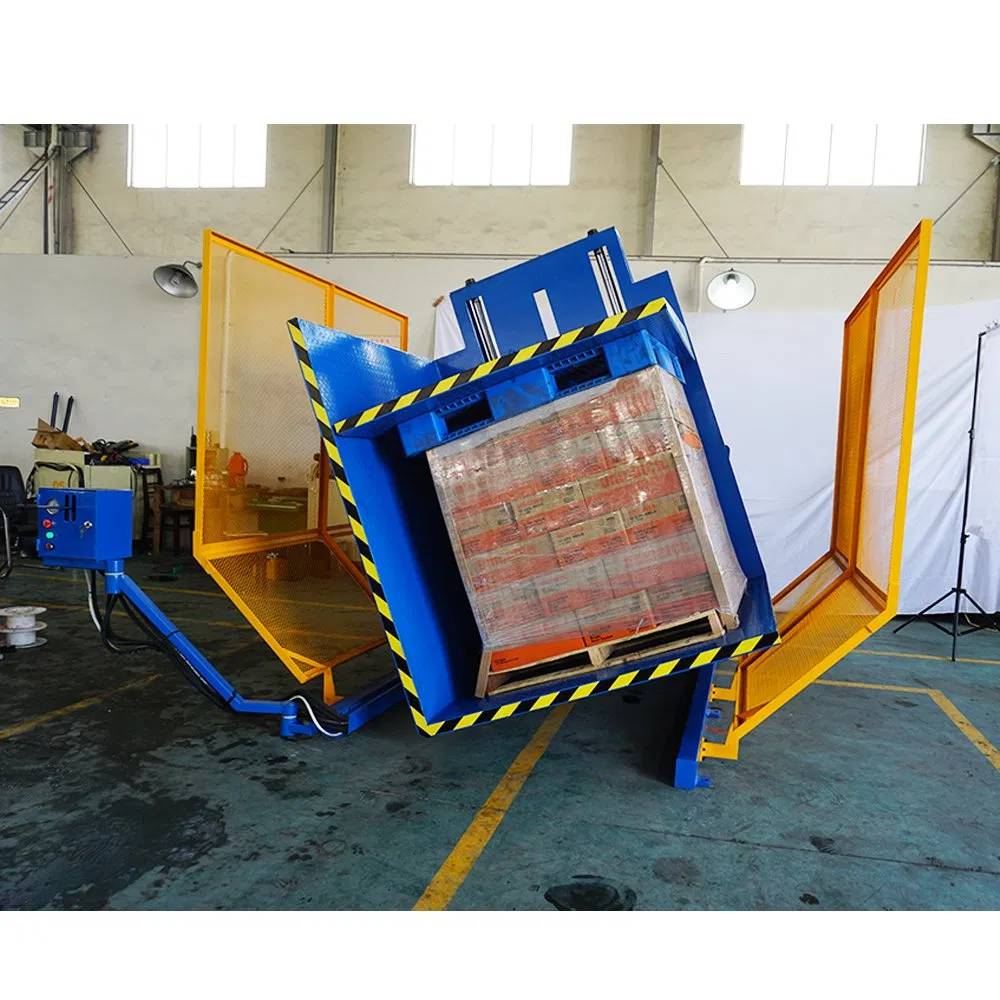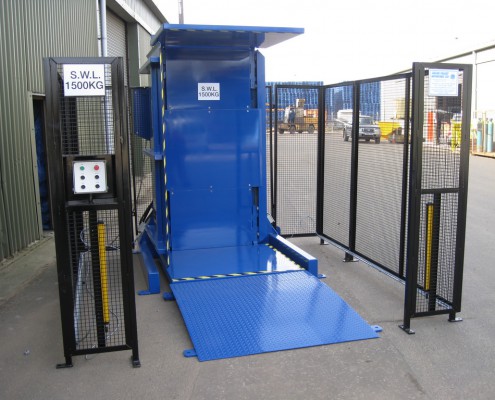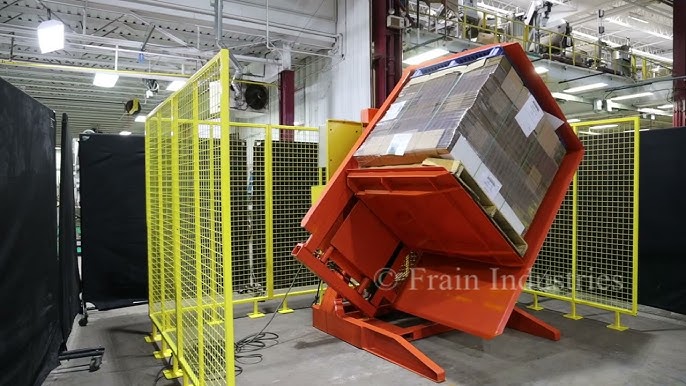Pallet Inverter: How to Change Pallets on Fully-Loaded Freight Easily?
Running a steel mill is a massive undertaking. I know this because I've spent my entire career in and around heavy manufacturing. You're constantly balancing immense pressures: fluctuating energy costs, aging equipment, and the ever-present need to produce more with less. One of the most common, yet overlooked, bottlenecks I've seen is in the final stages of handling—specifically, dealing with pallets. A single broken pallet or the need to switch from an in-house pallet to a shipping-grade one can bring a part of your operation to a halt. You're faced with the slow, risky, and expensive task of manually restacking heavy loads. This process eats up valuable time, puts your employees at risk, and can even damage the very products you've worked so hard to create. It's a small problem that creates big headaches and chips away at your profit margins. But what if you could solve this entire issue in under 60 seconds with a single machine?
A pallet inverter is a piece of machinery designed to safely and quickly transfer a fully loaded pallet of goods to a new pallet. It works by clamping the load securely, rotating it 180 degrees, and allowing the old pallet to be removed from the top. Then, a new pallet is placed on the load, and the machine rotates back, setting the goods down on the new pallet without any manual handling. This simple, automated process eliminates the need for manual restacking, drastically reducing labor time, preventing product damage, and improving overall warehouse safety.

This might sound like just another piece of equipment to add to your capital expenditure list. But as someone who has built a business on optimizing these exact kinds of processes, I encourage you to look closer. For a pragmatic leader like you, Javier, who analyzes every investment for its return, a pallet inverter isn't an expense; it's a strategic tool. It directly addresses your goals of improving产能利用率 (capacity utilization), lowering operational costs, and even supporting your digital transformation by streamlining a critical physical task. Let's break down how this technology works and why it's become essential for modern, efficient operations like yours.
What is a Pallet Inverter and How Does It Actually Work?
You've seen countless machines on your factory floor, each with a specific purpose. But sometimes, a simple concept can be revolutionary. You might be wondering if a pallet inverter is just another complex machine that will require extensive training and maintenance. You’ve probably seen equipment that promised simplicity but delivered headaches, adding to your team's workload instead of reducing it. The good news is, the principle behind a pallet inverter is refreshingly straightforward. It’s a solution born from a clear, practical need: to change a pallet without touching the product.
A pallet inverter works through a simple, robust mechanical process. First, a forklift places the fully loaded pallet into the machine's loading bay. The machine then uses adjustable hydraulic clamps to gently but firmly secure the load from the top and bottom. Once the load is secure, the entire unit rotates 180 degrees. The original pallet is now on top, free to be lifted off and replaced. After placing the new pallet, the machine rotates back 180 degrees, and the forklift can remove the load, now resting securely on its new pallet.

Dive Deeper: The Mechanics of Pallet Inversion
To truly appreciate its value, it helps to understand the engineering behind it. As an engineer myself, I always believe that knowing how a machine works is the first step to trusting it. Let's look at the core components and the different types you might encounter.
Core Operating Principles
The magic of the pallet inverter lies in its combination of strength and control.
- Loading: The process begins when a forklift operator drives a fully loaded pallet directly onto the machine's base plate. Modern inverters are designed for easy access, often at ground level, which speeds up the process and reduces the risk of accidents.
- Clamping: This is the most critical phase. The machine uses a hydraulic system to lower a top clamping platform onto the load. The pressure is adjustable. This is vital in a steel mill where you might be handling anything from neatly stacked boxes of finished parts to less stable loads. You need enough pressure to hold everything securely, but not so much that you crush the product or packaging.
- Inversion (180° Rotation): A powerful motor drives the rotation. The entire clamped load is turned upside down. The design ensures a smooth, stable rotation, preventing any shifting of the product. The original pallet, which was on the bottom, is now sitting on top of the inverted load, completely accessible.
- Pallet Exchange: The operator can easily remove the old pallet with a forklift or by hand and place the new pallet in its position.
- Return Rotation: The machine rotates back to its original position, and the clamping platform retracts. The load is now ready to be picked up by a forklift, sitting perfectly on its new pallet.
Types of Pallet Inverters
Not all pallet inverters are the same. The right choice depends on your specific workflow, space, and load types.
| Feature | Free-Standing Inverter | Forklift-Loaded Inverter (FLI) | Ramp-Loaded Inverter |
|---|---|---|---|
| Loading Method | Forklift places pallet directly on the machine's turntable. | Machine attaches to forklift tines; it goes to the pallet stack. | Pallet jack or hand truck can load at ground level via a ramp. |
| Best For | Centralized pallet changing station with high volume. | Mobile operations where you need to change pallets in various locations. | Areas where forklifts are not always available or practical. |
| Footprint | Requires a dedicated floor space. | Minimal, as it's part of the forklift. | Larger footprint due to the ramp. |
| Ideal Load | Heavy, stable loads like steel coils, bagged goods, boxes. | Versatile for various load types but limited by forklift capacity. | Lighter to medium-weight loads. |
| My Take | For a high-capacity steel mill like yours, a heavy-duty, free-standing model is almost always the most robust and efficient choice. It can be integrated directly into your production or warehouse line and handle the weights you deal with daily. |
Understanding these mechanics shows that the pallet inverter is not a black box. It's a purpose-built tool designed for reliability and simplicity, directly targeting a common and costly problem.
Why is Manual Pallet Changing a Hidden Cost in Your Steel Mill?
As a factory owner, you are acutely aware of your major costs—energy, raw materials, and labor. But I've learned that the most dangerous costs are the ones that hide in plain sight, disguised as "business as usual." Manual pallet changing is one of the biggest culprits. You see your workers breaking down a pallet, and you think, "It's just part of the job." But when you look closer, you start to see the time ticking away, the risk of a dropped product, and the potential for a serious back injury. These aren't just minor issues; they are real, quantifiable costs that erode your profitability and efficiency, directly opposing your goal to cut operational costs by 8%.
Manual pallet changing is a significant hidden cost because it consumes excessive labor hours, creates unnecessary production downtime, leads to costly product damage from mishandling, and exposes your company to high financial risks associated with workplace injuries. Each of these factors directly impacts your bottom line, turning a seemingly simple task into a major source of operational inefficiency and financial drain.

Dive Deeper: Uncovering the True Financial Impact
Let's put on our engineer hats and do a cost analysis. When I ran my factory, I made it a habit to question every process that seemed inefficient. Let's break down the costs of manual restacking in a way that relates directly to your steel mill operations.
The True Cost of Labor and Time
Imagine you need to switch a pallet under a 1.5-ton stack of finished steel components.
- Manual Method: This requires at least two workers and a forklift. They have to carefully destack the product onto an empty pallet, move the old pallet away, and then restack the product onto the new one. This can easily take 15-20 minutes, assuming everything goes perfectly. If you do this just 20 times a day, that’s over 6 hours of labor tied up in a non-value-added task.
- Pallet Inverter Method: One forklift operator can perform the entire task in less than 2 minutes. The math is stark. You're not just saving labor hours; you're freeing up your team and your forklift for more productive work, like loading trucks or feeding the production line.
The High Price of Product Damage
In the steel industry, your products are heavy and can have finished surfaces that need protection.
- Manual Risk: Every time a worker handles a product, there's a risk of it being dropped, scratched, or dented. When you're restacking an entire pallet, that risk is multiplied. A single damaged component might have to be scrapped or reworked, wiping out the profit on that entire pallet.
- Inverter Solution: The pallet inverter clamps the load as a single, stable unit. The product itself is never handled individually. The clamping pressure is controlled to be secure without causing damage. This reduces the risk of product damage to virtually zero.
The Unseen Cost of Downtime and Bottlenecks
Your goal is 95%产能利用率 (capacity utilization). A bottleneck in the warehouse can ripple backward and stall your production line.
- Manual Bottleneck: If outgoing trucks are waiting for pallets to be switched, or if your internal logistics are held up by this slow process, you're creating a bottleneck. This is not just inefficient; it can directly impact your ability to meet production and shipping schedules.
- Inverter Efficiency: By reducing a 20-minute task to a 2-minute one, you eliminate that bottleneck completely. The flow of goods becomes smoother and more predictable, which is essential for achieving high utilization rates.
| Cost Factor | Manual Pallet Changing (Per Pallet) | Pallet Inverter (Per Pallet) | Annual Savings (Estimate for 20 pallets/day) |
|---|---|---|---|
| Labor Time | 2 workers, 20 minutes (40 total minutes) | 1 worker, 2 minutes (2 total minutes) | > 9,500 labor hours saved |
| Forklift Time | 20 minutes | 2 minutes | > 150 hours of forklift time freed up |
| Risk of Damage | Moderate to High | Extremely Low | Significant reduction in scrap/rework costs |
| Risk of Injury | High (lifting, repetitive motion) | Negligible | Lower insurance premiums, fewer lost workdays |
When you look at these numbers, it becomes clear. Manual pallet changing isn't "just part of the job." It's a silent drain on your resources.
How Can a Pallet Inverter Directly Boost Your Operational Efficiency and Safety?
Every decision you make as a CEO comes down to a few key questions: Will this make us better? Faster? Safer? More profitable? You are targeting a 95% equipment effective run time and a significant cost reduction. These are ambitious goals that can't be met by simply working harder. You need to work smarter. You might be skeptical that a single machine in the warehouse can have such a big impact. But think about the ripple effect of a bottleneck. A small delay in one area can cascade through the entire system. A pallet inverter is a tool that smooths out one of those critical ripples.
A pallet inverter directly boosts operational efficiency by transforming a slow, multi-step manual process into a single, automated action that takes less than two minutes. This speed frees up labor and equipment for core tasks, eliminates bottlenecks in shipping and receiving, and drastically improves workplace safety by removing the need for manual lifting of heavy loads, helping you achieve higher throughput and lower injury-related costs.

Dive Deeper: From Bottleneck to Competitive Advantage
Let’s connect this directly to your strategic goals. I've helped clients implement these systems, and the results consistently align with the objectives you've set for your steel mill.
Achieving Your 95% Uptime Goal
Your production lines are the heart of your operation. To keep them running, the flow of materials—both raw and finished—must be seamless.
- Before: A damaged pallet arriving with raw materials could halt unloading until it's manually restacked. A finished load on the wrong pallet can delay shipment. These "micro-stops" add up and pull down your overall equipment effectiveness (OEE).
- After: With a pallet inverter, these issues are resolved in minutes. A damaged incoming pallet is swapped immediately, and the materials are sent to the line without delay. An outgoing load is quickly transferred to an export-grade pallet, ensuring trucks leave on time. By eliminating these logistical delays, you protect the uptime of your most valuable production assets. The pallet inverter acts as a buffer, absorbing logistical problems before they can impact production.
A Quantum Leap in Workplace Safety
As a leader, the safety of your people is paramount. The steel industry is hazardous by nature, and reducing risk is a constant priority. Manual restacking is a major, and unnecessary, risk.
- The Old Way: It involves repetitive bending, lifting heavy objects, and twisting—a perfect recipe for musculoskeletal injuries, which are among the most common and costly workplace incidents. A single serious injury can lead to lost workdays, higher insurance premiums, and potential regulatory fines, not to mention the impact on employee morale.
- The Smart Way: The pallet inverter eliminates all of this. The only manual action is operating the controls. This simple change can have a profound impact on your safety record and aligns perfectly with modern environmental, social, and governance (ESG) standards that investors and partners value.
Streamlining Your Workflow for Digitalization
You are committed to deploying MES and IoT platforms. This is about making your processes visible, predictable, and optimized. A pallet inverter fits perfectly into this vision. It standardizes a previously chaotic process.
| Step | Traditional Pallet Exchange Workflow | Pallet Inverter Workflow |
|---|---|---|
| 1. Identify | Worker identifies a bad pallet. | Worker identifies a bad pallet. |
| 2. Prepare | Find two available workers, find an available forklift, find empty space. | Move load to the pallet inverter station. |
| 3. Execute | Manually unstack goods onto a new pallet (15-20 min). | Load machine, press a button, exchange pallet, unload (2 min). |
| 4. Cleanup | Restack boxes, clean up debris, return forklift. | Remove the old pallet. |
| 5. Result | Process is variable, slow, risky, and hard to track. | Process is standardized, fast, safe, and predictable. |
By standardizing this task, you create a predictable time and resource requirement. This data point can be fed into your MES, making your overall logistics planning more accurate. It's a physical automation that supports your digital strategy.
What Key Factors Should You Consider When Choosing a Pallet Inverter for Heavy-Duty Applications?
You've made it this far, so you see the potential. But as an experienced leader, you know the devil is in the details. Making the decision to invest is one thing; making the right investment is another. In a demanding environment like a steel mill, not just any pallet inverter will do. Your equipment is subjected to heavy loads, continuous use, and a less-than-pristine environment. Choosing an under-specced machine would be a costly mistake, leading to downtime and maintenance headaches—the very things you're trying to avoid.
When selecting a pallet inverter for heavy-duty applications like a steel mill, you must prioritize four key factors: robust load capacity and construction, precise and adjustable clamping pressure to protect your products, seamless integration and automation capabilities to fit your workflow, and the reliability and support offered by the supplier. Getting these right ensures your investment delivers long-term value instead of becoming another maintenance problem.

Dive Deeper: A Buyer's Guide for the Pragmatic CEO
You're not just buying a machine; you're investing in a solution and partnering with a supplier. Here is the thought process I recommend to clients like you, focusing on the factors that matter most for heavy industrial use.
1. Load Capacity and Structural Integrity
This is non-negotiable. A machine's stated capacity should be well above your typical maximum load.
- What to look for: Ask about the steel thickness, the quality of the welds, and the type of motor and hydraulic system used. Look for heavy-gauge steel construction. For a 2 million-ton steel mill, you should be looking at inverters rated for at least 2,000 kg (4,400 lbs) or more, depending on your specific products. The machine needs to be built not just to lift the weight, but to do it thousands of times without fatigue.
- My advice: Don't just trust the spec sheet. Ask for case studies or references from companies in similar industries. A good supplier will be proud to share them.
2. Adjustable Clamping Pressure: Protecting Your Assets
Your products vary. A pallet of raw materials can be clamped tightly. A pallet of finished, painted components needs a gentler touch.
- What to look for: A high-quality inverter will have a hydraulic system with a pressure relief valve and adjustable controls. This allows your operators to set the clamping force precisely for each type of load. This prevents product damage, from crushed boxes to scratched surfaces.
- My advice: This feature is what separates a basic machine from a professional-grade solution. It shows the manufacturer understands the nuances of material handling.
3. Integration and Automation Level
How will this machine fit into your factory? Your goal is digitalization and efficiency. The machine should support that.
- What to look for: Can it be loaded from multiple sides? Can it be integrated with conveyor systems for a fully automated line? Does it have safety features like light curtains or safety fencing to protect your workers? The level of automation should match your ambition. You can start with a standalone unit and later integrate it into a larger system.
- My advice: Think about your five-year plan. Buy a machine that can grow with you. A supplier who can discuss automation and integration is a partner, not just a vendor.
4. The Supplier: Your Strategic Partner
This is perhaps the most important factor. As you said yourself, you're looking for a strategic partner.
- What to look for: Do they offer installation, training, and after-sales support? What is their warranty policy? Can they provide spare parts quickly? A cheap machine from an unreliable supplier is the most expensive machine you can buy.
- My advice: This is where I founded SHJLPACK on the principle of being a total solution provider. A partner should understand your business, not just their product. They should be able to provide expert advice on everything from selection to maintenance.
| Feature to Check | Why It Matters for a Steel Mill | What to Ask the Supplier |
|---|---|---|
| Construction Material | Durability in a tough environment. | "What grade and thickness of steel do you use in the frame?" |
| Hydraulic System | Reliability and control under heavy loads. | "Can you detail the components of the hydraulic power pack?" |
| Adjustable Clamps | Prevents damage to valuable finished products. | "Show me how the clamping pressure is adjusted and controlled." |
| Safety Features | Protects your employees and reduces liability. | "What are the standard and optional safety features (e.g., light curtains, fencing)?" |
| After-Sales Support | Minimizes downtime if an issue occurs. | "What is your process for service and spare parts delivery to Mexico?" |
Choosing the right pallet inverter is a technical decision that supports a strategic business goal. By being thorough, you ensure this investment pays dividends for years to come.
My Insights: Beyond the Machine
When I first started my own factory, every dollar counted. I understand the pressure of making a capital investment. I remember looking at a particular bottleneck in my own line—it was a packaging step—and I hesitated to spend the money on the automation that I knew, as an engineer, was the right answer. I tried to solve it by adding more labor and rearranging the workflow. It was a temporary fix, but the core problem remained. It was slow, inconsistent, and created stress for my team.
Finally, I made the investment. The change was immediate. The bottleneck disappeared. My team was less stressed and could focus on quality control. Throughput went up. It was a powerful lesson: sometimes, the bravest business decision is to invest in eliminating a "small" but persistent problem.
A pallet inverter is one of those investments. It’s easy to look at the price tag and compare it to the "cost" of having your workers do it manually. But that's the wrong comparison. The manual way has immense hidden costs: the risk of injury, the cost of damaged goods, the lost time, the production delays. The pallet inverter doesn't just replace labor; it buys you speed, safety, and predictability. In a business like yours, Javier, where efficiency is measured in seconds and tons, predictability is priceless. It's the foundation upon which you can build your digital factory and achieve your goal of 95% utilization.
Don't think of it as just buying a pallet inverter. Think of it as eliminating a source of risk and inefficiency forever. It’s a step towards a more streamlined, safer, and more profitable operation. It’s the kind of practical, high-ROI solution that I built my own success on, and it’s why I’m so passionate about sharing this knowledge today.
Conclusion
A pallet inverter is a strategic investment that simplifies logistics, boosts safety, and cuts hidden costs, turning a major operational bottleneck into a source of efficiency and a competitive advantage.



